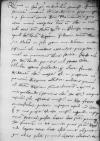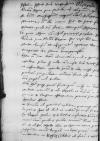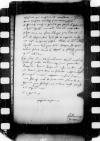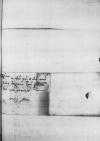24 huius venit huc Mauritius (Moritz), at least in 1537-1547 servant of Ioannes Dantiscus, often sent with letters and packages to the royal court (CIDTC, e.g. IDL 1630, IDL 4476, IDL 3266, IDL 3279)⌊MauritiusMauritius (Moritz), at least in 1537-1547 servant of Ioannes Dantiscus, often sent with letters and packages to the royal court (CIDTC, e.g. IDL 1630, IDL 4476, IDL 3266, IDL 3279)⌋, a quo citra moram acceptas litteras cum oleo in arcem tuli, erat tunc Bona Sforza (*1494 – †1557), Queen of Poland and Grand Duchess of Lithuania (1518-1557); the second wife of Sigismund I Jagiellon; Duchess of Bari and Rossano; daughter of Gian Galeazzo Sforza of Milan and Isabella of Aragon⌊maiestas reginalisBona Sforza (*1494 – †1557), Queen of Poland and Grand Duchess of Lithuania (1518-1557); the second wife of Sigismund I Jagiellon; Duchess of Bari and Rossano; daughter of Gian Galeazzo Sforza of Milan and Isabella of Aragon⌋ in Kwrza Noga[1] apud decumbentem Sigismund I Jagiellon (Zygmunt I) (*1467 – †1548), King of Poland and Grand Duke of Lithuania (1506-1548); Duke of Głogów (Glogau) (1499-1506), Duke of Opava (1501-1506), Governor of Silesia (1504-1506); son of King Kazimierz IV Jagiellon and Elisabeth of Austria⌊regemSigismund I Jagiellon (Zygmunt I) (*1467 – †1548), King of Poland and Grand Duke of Lithuania (1506-1548); Duke of Głogów (Glogau) (1499-1506), Duke of Opava (1501-1506), Governor of Silesia (1504-1506); son of King Kazimierz IV Jagiellon and Elisabeth of Austria⌋, hilarem tamen. Nam Sigismund I Jagiellon (Zygmunt I) (*1467 – †1548), King of Poland and Grand Duke of Lithuania (1506-1548); Duke of Głogów (Glogau) (1499-1506), Duke of Opava (1501-1506), Governor of Silesia (1504-1506); son of King Kazimierz IV Jagiellon and Elisabeth of Austria⌊sua maiestasSigismund I Jagiellon (Zygmunt I) (*1467 – †1548), King of Poland and Grand Duke of Lithuania (1506-1548); Duke of Głogów (Glogau) (1499-1506), Duke of Opava (1501-1506), Governor of Silesia (1504-1506); son of King Kazimierz IV Jagiellon and Elisabeth of Austria⌋ in solo genu uno dolorem intensissimum, ubi incedere attentat, propter motum et curvationem illius sentit, stando autem seu decumbendo penitus nil sentit dolet.
Multa essent scribenda, quam alacri fronte desideratum oleum acceptum est in praesentia non paucorum, Bona Sforza (*1494 – †1557), Queen of Poland and Grand Duchess of Lithuania (1518-1557); the second wife of Sigismund I Jagiellon; Duchess of Bari and Rossano; daughter of Gian Galeazzo Sforza of Milan and Isabella of Aragon⌊reginaBona Sforza (*1494 – †1557), Queen of Poland and Grand Duchess of Lithuania (1518-1557); the second wife of Sigismund I Jagiellon; Duchess of Bari and Rossano; daughter of Gian Galeazzo Sforza of Milan and Isabella of Aragon⌋ callidior, audiens primum ad Sigismund I Jagiellon (Zygmunt I) (*1467 – †1548), King of Poland and Grand Duke of Lithuania (1506-1548); Duke of Głogów (Glogau) (1499-1506), Duke of Opava (1501-1506), Governor of Silesia (1504-1506); son of King Kazimierz IV Jagiellon and Elisabeth of Austria⌊maiestatem regiamSigismund I Jagiellon (Zygmunt I) (*1467 – †1548), King of Poland and Grand Duke of Lithuania (1506-1548); Duke of Głogów (Glogau) (1499-1506), Duke of Opava (1501-1506), Governor of Silesia (1504-1506); son of King Kazimierz IV Jagiellon and Elisabeth of Austria⌋ commendationem Vestrae Reverendissimae Dominationis, interpellando (sentiens oleum hoc esse) arripuit vasculum, sibi asserens missum, cui rex facete contrastabat, interim inscriptio vasculi non lecta, sed ex me quaesitum est, utri missum. Respondi inscriptionem docturam, postea litterae lectae sunt, primaeque haec fuerunt in tot annis, quas solum regem vidi legere totas, licet astitimus aliquot, qui alias soliti sumus legere, oblatas, et  AAWO, AB, D. 4, f. 112v praesertim praesente domino Paweł Dunin-Wolski (Paweł Wolski) (†1546), 1533-1543 Starost of Gostynin; 1532-1537 Castellan of Sochaczew; 1537-1539 Vice-Chancellor of the Crown; 1537-1546 Burgrave of Cracow; 1539-1544 Grand Chancellor of the Crown; 1539-1544 Castellan of Radom; 1544-1546 Bishop of Poznań (after the death of his wife) (Urzędnicy 10, p. 214)⌊vicecancellarioPaweł Dunin-Wolski (Paweł Wolski) (†1546), 1533-1543 Starost of Gostynin; 1532-1537 Castellan of Sochaczew; 1537-1539 Vice-Chancellor of the Crown; 1537-1546 Burgrave of Cracow; 1539-1544 Grand Chancellor of the Crown; 1539-1544 Castellan of Radom; 1544-1546 Bishop of Poznań (after the death of his wife) (Urzędnicy 10, p. 214)⌋. Misit postea sua Sigismund I Jagiellon (Zygmunt I) (*1467 – †1548), King of Poland and Grand Duke of Lithuania (1506-1548); Duke of Głogów (Glogau) (1499-1506), Duke of Opava (1501-1506), Governor of Silesia (1504-1506); son of King Kazimierz IV Jagiellon and Elisabeth of Austria⌊maiestas regiaSigismund I Jagiellon (Zygmunt I) (*1467 – †1548), King of Poland and Grand Duke of Lithuania (1506-1548); Duke of Głogów (Glogau) (1499-1506), Duke of Opava (1501-1506), Governor of Silesia (1504-1506); son of King Kazimierz IV Jagiellon and Elisabeth of Austria⌋ pro scatula, ubi reliquum a Reverendissima Dominatione Vestra dominum Andrzej Krzycki (Andreas Cricius) (*1482 – †1537), humanist, neo-Latin poet, diplomat, correspondent of Erasmus of Rotterdam; in 1525 he took part in the negotiations leading to the secularisation of the state of the Teutonic Order; from 1504 Canon of Poznań (from 1511 Scholastic, from 1519 Provost); from 1512 Canon of Cracow, Scholastic of Płock, and secretary to the first wife of Sigismund I Jagiellon, Barbara Zápolya; 1515-1523 royal secretary; 1518-1530 Provost of the Chapter of St. Florian in Cracow; 1522-1525 Bishop of Przemyśl; 1525-1527 Bishop of Poznań; 1527-1535 Bishop of Płock; 1535-1537 Archbishop of Gniezno, Primate of Poland (PSB 15, p.544-549)⌊archiepiscopumAndrzej Krzycki (Andreas Cricius) (*1482 – †1537), humanist, neo-Latin poet, diplomat, correspondent of Erasmus of Rotterdam; in 1525 he took part in the negotiations leading to the secularisation of the state of the Teutonic Order; from 1504 Canon of Poznań (from 1511 Scholastic, from 1519 Provost); from 1512 Canon of Cracow, Scholastic of Płock, and secretary to the first wife of Sigismund I Jagiellon, Barbara Zápolya; 1515-1523 royal secretary; 1518-1530 Provost of the Chapter of St. Florian in Cracow; 1522-1525 Bishop of Przemyśl; 1525-1527 Bishop of Poznań; 1527-1535 Bishop of Płock; 1535-1537 Archbishop of Gniezno, Primate of Poland (PSB 15, p.544-549)⌋ acceptum oleum diligenter servatur, cum illo inani hic ex siccis floribus extracto, quod tunc statim contemptum segregatum. Et quia adhuc nonnihil prioris probati habetur, noluit sua Sigismund I Jagiellon (Zygmunt I) (*1467 – †1548), King of Poland and Grand Duke of Lithuania (1506-1548); Duke of Głogów (Glogau) (1499-1506), Duke of Opava (1501-1506), Governor of Silesia (1504-1506); son of King Kazimierz IV Jagiellon and Elisabeth of Austria⌊maiestas regiaSigismund I Jagiellon (Zygmunt I) (*1467 – †1548), King of Poland and Grand Duke of Lithuania (1506-1548); Duke of Głogów (Glogau) (1499-1506), Duke of Opava (1501-1506), Governor of Silesia (1504-1506); son of King Kazimierz IV Jagiellon and Elisabeth of Austria⌋ hoc vasculum tam diligenter clausum et obsignatum aperire, ne, inquit, evaporet, ita serva Lwgowski.
AAWO, AB, D. 4, f. 112v praesertim praesente domino Paweł Dunin-Wolski (Paweł Wolski) (†1546), 1533-1543 Starost of Gostynin; 1532-1537 Castellan of Sochaczew; 1537-1539 Vice-Chancellor of the Crown; 1537-1546 Burgrave of Cracow; 1539-1544 Grand Chancellor of the Crown; 1539-1544 Castellan of Radom; 1544-1546 Bishop of Poznań (after the death of his wife) (Urzędnicy 10, p. 214)⌊vicecancellarioPaweł Dunin-Wolski (Paweł Wolski) (†1546), 1533-1543 Starost of Gostynin; 1532-1537 Castellan of Sochaczew; 1537-1539 Vice-Chancellor of the Crown; 1537-1546 Burgrave of Cracow; 1539-1544 Grand Chancellor of the Crown; 1539-1544 Castellan of Radom; 1544-1546 Bishop of Poznań (after the death of his wife) (Urzędnicy 10, p. 214)⌋. Misit postea sua Sigismund I Jagiellon (Zygmunt I) (*1467 – †1548), King of Poland and Grand Duke of Lithuania (1506-1548); Duke of Głogów (Glogau) (1499-1506), Duke of Opava (1501-1506), Governor of Silesia (1504-1506); son of King Kazimierz IV Jagiellon and Elisabeth of Austria⌊maiestas regiaSigismund I Jagiellon (Zygmunt I) (*1467 – †1548), King of Poland and Grand Duke of Lithuania (1506-1548); Duke of Głogów (Glogau) (1499-1506), Duke of Opava (1501-1506), Governor of Silesia (1504-1506); son of King Kazimierz IV Jagiellon and Elisabeth of Austria⌋ pro scatula, ubi reliquum a Reverendissima Dominatione Vestra dominum Andrzej Krzycki (Andreas Cricius) (*1482 – †1537), humanist, neo-Latin poet, diplomat, correspondent of Erasmus of Rotterdam; in 1525 he took part in the negotiations leading to the secularisation of the state of the Teutonic Order; from 1504 Canon of Poznań (from 1511 Scholastic, from 1519 Provost); from 1512 Canon of Cracow, Scholastic of Płock, and secretary to the first wife of Sigismund I Jagiellon, Barbara Zápolya; 1515-1523 royal secretary; 1518-1530 Provost of the Chapter of St. Florian in Cracow; 1522-1525 Bishop of Przemyśl; 1525-1527 Bishop of Poznań; 1527-1535 Bishop of Płock; 1535-1537 Archbishop of Gniezno, Primate of Poland (PSB 15, p.544-549)⌊archiepiscopumAndrzej Krzycki (Andreas Cricius) (*1482 – †1537), humanist, neo-Latin poet, diplomat, correspondent of Erasmus of Rotterdam; in 1525 he took part in the negotiations leading to the secularisation of the state of the Teutonic Order; from 1504 Canon of Poznań (from 1511 Scholastic, from 1519 Provost); from 1512 Canon of Cracow, Scholastic of Płock, and secretary to the first wife of Sigismund I Jagiellon, Barbara Zápolya; 1515-1523 royal secretary; 1518-1530 Provost of the Chapter of St. Florian in Cracow; 1522-1525 Bishop of Przemyśl; 1525-1527 Bishop of Poznań; 1527-1535 Bishop of Płock; 1535-1537 Archbishop of Gniezno, Primate of Poland (PSB 15, p.544-549)⌋ acceptum oleum diligenter servatur, cum illo inani hic ex siccis floribus extracto, quod tunc statim contemptum segregatum. Et quia adhuc nonnihil prioris probati habetur, noluit sua Sigismund I Jagiellon (Zygmunt I) (*1467 – †1548), King of Poland and Grand Duke of Lithuania (1506-1548); Duke of Głogów (Glogau) (1499-1506), Duke of Opava (1501-1506), Governor of Silesia (1504-1506); son of King Kazimierz IV Jagiellon and Elisabeth of Austria⌊maiestas regiaSigismund I Jagiellon (Zygmunt I) (*1467 – †1548), King of Poland and Grand Duke of Lithuania (1506-1548); Duke of Głogów (Glogau) (1499-1506), Duke of Opava (1501-1506), Governor of Silesia (1504-1506); son of King Kazimierz IV Jagiellon and Elisabeth of Austria⌋ hoc vasculum tam diligenter clausum et obsignatum aperire, ne, inquit, evaporet, ita serva Lwgowski.
Heri, cum Sigismund I Jagiellon (Zygmunt I) (*1467 – †1548), King of Poland and Grand Duke of Lithuania (1506-1548); Duke of Głogów (Glogau) (1499-1506), Duke of Opava (1501-1506), Governor of Silesia (1504-1506); son of King Kazimierz IV Jagiellon and Elisabeth of Austria⌊suam maiestatemSigismund I Jagiellon (Zygmunt I) (*1467 – †1548), King of Poland and Grand Duke of Lithuania (1506-1548); Duke of Głogów (Glogau) (1499-1506), Duke of Opava (1501-1506), Governor of Silesia (1504-1506); son of King Kazimierz IV Jagiellon and Elisabeth of Austria⌋ admonerem, si quid Vestrae Reverendissimae Dominationi vellet rescribere, hilari quoque vultu commisit domino vicecancellario, ut responderet, agendo gratias de oleo misso, quod probatum singularem utilitatem facit, etc. Ut in litteris scriptum, nil dubito.
Bona Sforza (*1494 – †1557), Queen of Poland and Grand Duchess of Lithuania (1518-1557); the second wife of Sigismund I Jagiellon; Duchess of Bari and Rossano; daughter of Gian Galeazzo Sforza of Milan and Isabella of Aragon⌊Maiestati reginaliBona Sforza (*1494 – †1557), Queen of Poland and Grand Duchess of Lithuania (1518-1557); the second wife of Sigismund I Jagiellon; Duchess of Bari and Rossano; daughter of Gian Galeazzo Sforza of Milan and Isabella of Aragon⌋ quoque gratum fuit, cum mihi in litteris ostenderet, articulum de Georg Hegel (†1547), the Thurzons' and later the Fuggers' factor in Cracow (worked for the Fuggers at least from 1521); supplier to the royal court in Cracow (PSB 9, p. 336)⌊Georgio HegelGeorg Hegel (†1547), the Thurzons' and later the Fuggers' factor in Cracow (worked for the Fuggers at least from 1521); supplier to the royal court in Cracow (PSB 9, p. 336)⌋, ut litteras dum a domino comite de Nassaw afferentur, prius suae maiestati legendas offerat.
De concilio nil penitus auditur, parvaque vel nulla potius spes est illud, ut indictum scimus futurum. Ex Naples (Napoli, Neapolis), city in Italy, on the coast of the Tyrrhenian Sea, capital of the region of Campania⌊NeapoliNaples (Napoli, Neapolis), city in Italy, on the coast of the Tyrrhenian Sea, capital of the region of Campania⌋ habui his diebus a factore dominorum The Fuggers German family of merchants and bankers that dominated European business during the 15th and 16th centuries⌊FuccarorumThe Fuggers German family of merchants and bankers that dominated European business during the 15th and 16th centuries⌋ litteras, quibus scribit timorem Suleiman the Magnificent (*1494 – †1566), 1520-1566 Sultan of the Ottoman Empire⌊TurcaeSuleiman the Magnificent (*1494 – †1566), 1520-1566 Sultan of the Ottoman Empire⌋ imminutum, et ob hoc tepid written over t⌈tdd written over t⌉e illic et Genoa (Genova, Genua, Ianua), city and capital of the homonymous Republic in north-western Italy, Liguria, on the Gulf of Genoa, a seaport from 1528 ally and satellite of Spain⌊GenuaeGenoa (Genova, Genua, Ianua), city and capital of the homonymous Republic in north-western Italy, Liguria, on the Gulf of Genoa, a seaport from 1528 ally and satellite of Spain⌋ arma parari suscipiuntur tamen Neapoli milites, quorum mille mittentur in regionem Calabria, region in southern Italy, south of Naples⌊CalabriaeCalabria, region in southern Italy, south of Naples⌋ ad farum e regione  AAWO, AB, D. 4, f. 113r Messina, city on the island of Sicily, capital of the province of Messina⌊MessinaeMessina, city on the island of Sicily, capital of the province of Messina⌋, qui ingruente necessitate in paucis horis traicere Sicily, island in the Mediterranean Sea, Kingdom ruled by the Habsburgs⌊SiciliaeSicily, island in the Mediterranean Sea, Kingdom ruled by the Habsburgs⌋que succurrere possunt.
AAWO, AB, D. 4, f. 113r Messina, city on the island of Sicily, capital of the province of Messina⌊MessinaeMessina, city on the island of Sicily, capital of the province of Messina⌋, qui ingruente necessitate in paucis horis traicere Sicily, island in the Mediterranean Sea, Kingdom ruled by the Habsburgs⌊SiciliaeSicily, island in the Mediterranean Sea, Kingdom ruled by the Habsburgs⌋que succurrere possunt.
8 huius misi Vestrae Reverendissimae Dominationi per servum Achatius von Zehmen (Achacy Cema) (*ca. 1485 – †1565), 1517-1531 Chamberlain of Pomerania, 1531-1546 Castellan of Gdańsk (Danzig), 1545-1546 Voivode of Kulm (Chełmno), 1546-1565 Voivode of Marienburg (Malbork) (SBPN 1, p. 194-195; ORACKI 1984, p. 38-39; Urzędnicy 5/2, p. 198; PSB 4, p. 325-326)⌊domini GedanensisAchatius von Zehmen (Achacy Cema) (*ca. 1485 – †1565), 1517-1531 Chamberlain of Pomerania, 1531-1546 Castellan of Gdańsk (Danzig), 1545-1546 Voivode of Kulm (Chełmno), 1546-1565 Voivode of Marienburg (Malbork) (SBPN 1, p. 194-195; ORACKI 1984, p. 38-39; Urzędnicy 5/2, p. 198; PSB 4, p. 325-326)⌋ sculptum lapillum carneolum. Nunc autem mitto eadem sculpta arma in ferro oblongo, quo licet uti non solum ad obsignandas litteras, sed et argentea ac stannea vasa eo signari possunt, mitto et alium calibeum lapillum annularem pro domino probably Georg von Höfen (Georg Flachsbinder, Georgius de Curiis) (†after 1550-02-07), Ioannes Dantiscus' brother; Starosta of Rössel (HARTMANN 1525-1550, No. 584, 586, 588; AGAD, MK, 77, f. 385-386v)⌊Georgioprobably Georg von Höfen (Georg Flachsbinder, Georgius de Curiis) (†after 1550-02-07), Ioannes Dantiscus' brother; Starosta of Rössel (HARTMANN 1525-1550, No. 584, 586, 588; AGAD, MK, 77, f. 385-386v)⌋, de his tribus solvit dominus Georg Hegel (†1547), the Thurzons' and later the Fuggers' factor in Cracow (worked for the Fuggers at least from 1521); supplier to the royal court in Cracow (PSB 9, p. 336)⌊Georgius HegelGeorg Hegel (†1547), the Thurzons' and later the Fuggers' factor in Cracow (worked for the Fuggers at least from 1521); supplier to the royal court in Cracow (PSB 9, p. 336)⌋ 4 florenos, prout aequum videbatur.
Ego licet non in toto convaluerim, tamen melius habeo quam antea. Abiturusque sum perendie Naples (Napoli, Neapolis), city in Italy, on the coast of the Tyrrhenian Sea, capital of the region of Campania⌊NeapolimNaples (Napoli, Neapolis), city in Italy, on the coast of the Tyrrhenian Sea, capital of the region of Campania⌋, Bari (Barium, Status Barensis), duchy in southern Italy, on the Adriatic Sea, Bari was a hereditary country of Queen Bona of Poland⌊BariumBari (Barium, Status Barensis), duchy in southern Italy, on the Adriatic Sea, Bari was a hereditary country of Queen Bona of Poland⌋, Rossano, duchy in southern Italy, Calabria⌊RossanumRossano, duchy in southern Italy, Calabria⌋, etc. tandem ad Charles V of Habsburg (*1500 – †1558), ruler of the Burgundian territories (1506-1555), King of Spain as Charles I (1516-1556), King of Naples and Sicily, King of the Romans (1519-1530), Holy Roman Emperor of the German Nation (elected 1519, crowned 1530, abdicated 1556); son of Philip I the Handsome and Joanna the Mad of Castile⌊caesaream maiestatemCharles V of Habsburg (*1500 – †1558), ruler of the Burgundian territories (1506-1555), King of Spain as Charles I (1516-1556), King of Naples and Sicily, King of the Romans (1519-1530), Holy Roman Emperor of the German Nation (elected 1519, crowned 1530, abdicated 1556); son of Philip I the Handsome and Joanna the Mad of Castile⌋. Faxit Deus ut feliciter negotia Sigismund I Jagiellon (Zygmunt I) (*1467 – †1548), King of Poland and Grand Duke of Lithuania (1506-1548); Duke of Głogów (Glogau) (1499-1506), Duke of Opava (1501-1506), Governor of Silesia (1504-1506); son of King Kazimierz IV Jagiellon and Elisabeth of Austria
Bona Sforza (*1494 – †1557), Queen of Poland and Grand Duchess of Lithuania (1518-1557); the second wife of Sigismund I Jagiellon; Duchess of Bari and Rossano; daughter of Gian Galeazzo Sforza of Milan and Isabella of Aragon⌊serenissimorum principumSigismund I Jagiellon (Zygmunt I) (*1467 – †1548), King of Poland and Grand Duke of Lithuania (1506-1548); Duke of Głogów (Glogau) (1499-1506), Duke of Opava (1501-1506), Governor of Silesia (1504-1506); son of King Kazimierz IV Jagiellon and Elisabeth of Austria
Bona Sforza (*1494 – †1557), Queen of Poland and Grand Duchess of Lithuania (1518-1557); the second wife of Sigismund I Jagiellon; Duchess of Bari and Rossano; daughter of Gian Galeazzo Sforza of Milan and Isabella of Aragon⌋ meorum negotia conficiam. Interim me spemque meam de canonicatu commendo Dominationi Vestrae Reverendissimae, quae felicissime valeat.
 AAWO, AB, D. 4, f. 112v praesertim praesente domino
AAWO, AB, D. 4, f. 112v praesertim praesente domino  AAWO, AB, D. 4, f. 113r
AAWO, AB, D. 4, f. 113r 


